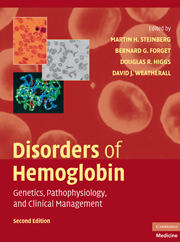Book contents
- Frontmatter
- Contents
- List of Contributors
- Foreword, by H. Franklin Bunn
- Preface
- Introduction, by David J. Weatherall
- SECTION ONE THE MOLECULAR, CELLULAR, AND GENETIC BASIS OF HEMOGLOBIN DISORDERS
- SECTION TWO PATHOPHYSIOLOGY OF HEMOGLOBIN AND ITS DISORDERS
- SECTION THREE α THALASSEMIA
- SECTION FOUR THE β THALASSEMIAS
- SECTION FIVE SICKLE CELL DISEASE
- SECTION SIX OTHER CLINICALLY IMPORTANT DISORDERS OF HEMOGLOBIN
- SECTION SEVEN SPECIAL TOPICS IN HEMOGLOBINOPATHIES
- SECTION EIGHT NEW APPROACHES TO THE TREATMENT OF HEMOGLOBINOPATHIES AND THALASSEMIA
- 29 Transfusion and Iron Chelation Therapy in Thalassemia and Sickle Cell Disease
- 30 Induction of Fetal Hemoglobin in the Treatment of Sickle Cell Disease and β Thalassemia
- 31 Novel Approaches to Treatment
- 32 Stem Cell Transplantation
- 33 Prospects for Gene Therapy of Sickle Cell Disease and Thalassemia
- Index
- Plate section
- References
31 - Novel Approaches to Treatment
from SECTION EIGHT - NEW APPROACHES TO THE TREATMENT OF HEMOGLOBINOPATHIES AND THALASSEMIA
Published online by Cambridge University Press: 03 May 2010
- Frontmatter
- Contents
- List of Contributors
- Foreword, by H. Franklin Bunn
- Preface
- Introduction, by David J. Weatherall
- SECTION ONE THE MOLECULAR, CELLULAR, AND GENETIC BASIS OF HEMOGLOBIN DISORDERS
- SECTION TWO PATHOPHYSIOLOGY OF HEMOGLOBIN AND ITS DISORDERS
- SECTION THREE α THALASSEMIA
- SECTION FOUR THE β THALASSEMIAS
- SECTION FIVE SICKLE CELL DISEASE
- SECTION SIX OTHER CLINICALLY IMPORTANT DISORDERS OF HEMOGLOBIN
- SECTION SEVEN SPECIAL TOPICS IN HEMOGLOBINOPATHIES
- SECTION EIGHT NEW APPROACHES TO THE TREATMENT OF HEMOGLOBINOPATHIES AND THALASSEMIA
- 29 Transfusion and Iron Chelation Therapy in Thalassemia and Sickle Cell Disease
- 30 Induction of Fetal Hemoglobin in the Treatment of Sickle Cell Disease and β Thalassemia
- 31 Novel Approaches to Treatment
- 32 Stem Cell Transplantation
- 33 Prospects for Gene Therapy of Sickle Cell Disease and Thalassemia
- Index
- Plate section
- References
Summary
INTRODUCTION
Sickle cell disease and β thalassemia should be ideal genetic disorders for which to design specific therapies at the cellular, protein, or gene levels. First, normal and abnormal differentiated cells, bone marrow precursors, progenitors, and hematopoietic stem cells are easily obtained for ex vivo studies. Second, specific mutations of the β hemoglobin gene have been characterized; the abnormal structure of sickled hemoglobin (HbS) detailed at atomic resolution is available, the secondary cellular defects and, beyond the erythrocyte itself, the interactions of the defective erythrocytes with other blood or vascular components are better understood. Third, mouse models are available for in vivo evaluation of new therapies. Despite a detailed understanding of the genetics, molecular biology, and biochemistry of HbS and β thalassemia and their effects on the host erythrocyte, the pathogenesis of the organ and vascular dysfunctions observed in both sickle cell disease and β thalassemia remain incompletely understood and likely involve many complex and heterogeneous steps.
The complex pathophysiology of sickle cell disease, as detailed in earlier chapters, involves erythrocyte dehydration and interactions of sickle erythrocytes, leukocytes and platelets with the endothelium, and hemolysis, among many other factors. Severity of disease differs significantly among patients, whereas the HbS mutation is common to all patients (Chapter 27). Therefore, the original idea that a single pathophysiological mechanism, whose basis is polymerization of deoxygenated HbS that leads to sickling, is inadequate to explain the myriad of clinical variations.
- Type
- Chapter
- Information
- Disorders of HemoglobinGenetics, Pathophysiology, and Clinical Management, pp. 755 - 773Publisher: Cambridge University PressPrint publication year: 2009



